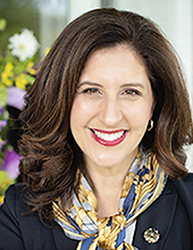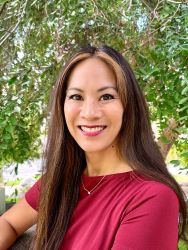You are here
Sage College DEI - Authors Women and Leadership

Author Spotlight*
See what inspired Lisa DeFrank-Cole and Sherylle J. Tan, authors of Women and Leadership: Journey Toward Equity.
What inspired you to become a textbook author?
Lisa DeFrank-Cole: Having taught leadership courses for more than a decade, I saw a gap when it came to the topic of women and leadership. I had developed a course by this title, but didn’t have a textbook to easily guide me through the semester. I would use a combination of journal articles, films, and chapters from edited books to provide content for students, but I really wished I had a textbook. Becoming a textbook author was not part of my plan, but sometimes reality steps in and leads one in a different direction!
Michael Carmichael, who is head of visual media at Sage, was speaking with me and my co-author, Sherylle J. Tan, about an upcoming project. As a closing question, he asked if either of us had any other suggestions. Without thinking, I said that I wished there was a textbook about women and leadership, much like a text published by Sage that many of us used in our introductory courses. Michael was meeting with the editor of that very book the next day, as luck would have it… “Would we like for him to mention this idea to her?” He asked if we would like to write this textbook. <gulp!> “Uh, yeah, I think so. We would definitely like to talk about a project like that,” I said. I could hardly believe I was having this conversation and excitement was building.
As good as his word, he mentioned the idea to acquisitions editor Maggie Stanley, made an email introduction, and then we set up a phone call and had contract in-hand within a few months. I still get energized thinking about how this happened and how fortunate we are to have written the book.
Sherylle J. Tan: Through my own research, I learned about the obstructions that women face on their leadership journeys. I discovered how those barriers—like the stereotypes and bias that I experienced even at an early age—impact women, how they can affect a woman’s self-efficacy, and how they hold women back. Women leaders, with both formal and informal authority, can make a difference. These women become role models, they make decisions, and they influence others.
Through writing this textbook, I am able to enact some change; we’re building an awareness of the reasons behind the imbalance of women in leadership roles and positions in all areas so students will begin to think critically about solutions and what can be done to improve the current state. I co-authored this textbook to lead through educating adults and children of any gender, to share my voice, my research, and what I learn with others.
What unique perspective or lived experience do you bring to your book that helps students relate to your content?
What unique perspective or lived experience do you bring to your book that helps students relate to your content?
Lisa DeFrank-Cole: Textbooks are generally not written by people like me. By and large, they were written by White men, especially in the field of leadership. Women have always been leaders, but few of them served in high-level positions, so books that investigated leaders were mainly focused on men and authored by men. Historically in the United States, women worked in the private sphere of their homes and did not have the same opportunities as men to be recognized for their leadership. These foundations created the systems that guide us today and societal norms still tell us that men are prototypical leaders. I wanted to document the reality of women and to highlight their accomplishments as leaders in both formal and informal roles. Sharing the stories of women who have made a difference and those who are currently leading—their barriers and solutions—is what I wanted to write.
In addition to being a woman, other identities that make me an atypical author include my being a first-generation, low-income college graduate raised in Appalachia. Of my immigrant grandparents, the most educated one attained only a fourth-grade education. As a professor at West Virginia University, I represent those who may be unfamiliar with college. I am inspired to write with a conversational tone so that all students who read our textbook will embrace the content without feeling intimidated by it as I was when I was a student reading academic texts.
I am proud to bring my background into the writing of a new book and hope students find it relatable, especially if they have a similar background to me. I want them to feel that they belong in a college classroom. I believe my lived experience will also enrich those who have a different upbringing than mine by helping them see a fresh perspective in an easy-to-read style.
Sherylle J. Tan: As a woman of color, I grew up rarely seeing anyone who looked like me represented anywhere. The movies, books, or magazines that I saw or read did not showcase the lives of Asian Americans in any context, let alone in high-profile leadership roles. Very few textbooks, especially on leadership, were not written by women, let alone by women of color. It was hard to see or think of myself as a leader, when very little exemplars of leadership were women or women of color.
Women are not a monolithic group and have many identities in addition to their gender. For this reason, intersectionality is an important perspective from which to view leadership and is essential to how we approached this book. As a Filipina American woman born from immigrants who worked hard for a better life, I was influenced by implicit limits dictated by cultural tradition and ideas—that is gender norms—of what a girl and woman should be. Yet, I was also loved and supported deeply by my family and taught that I could become and do anything. It is with those experiences in mind that I made sure our textbook included a diverse set of women leaders to profile who came from diverse backgrounds and occupations, as well as cited throughout the book. I was intentional about the leaders who were selected and hope that our readers see themselves in parts of the book.
How would you like to see your field advance conversations around DEI? In what areas is more research needed?
How would you like to see your field advance conversations around DEI? In what areas is more research needed?
Lisa DeFrank-Cole: There needs to be additional intersectional research looking at social identities and how they may help or hinder a person’s progress as a leader. There are many identities that a person can have, including gender, race, socio-economic status, geographic location, educational background, sexual orientation, and others. Leadership research in the past 50 years examined similarities and differences between women and men, but we have many identities, including those beyond the binary, that deserve exploration. Sex assigned at birth is only one aspect of identity, and we need researchers to disaggregate the data to tell us more about who gets to lead, who doesn’t, and how their identities impact their opportunities. I would like to see continued studies about those from marginalized communities, including LGBTQ+ people, and how their leadership is impacted by their identities.
Tell us about the student reader(s) you keep in mind as you write. Who has had the biggest impact on how you write for a student audience?
Tell us about the student reader(s) you keep in mind as you write. Who has had the biggest impact on how you write for a student audience?
Sherylle J. Tan: There are two types of student readers that I think about when I write. First, I keep in mind the students who have not seen anyone who looks like them as a leader. How can I make sure they are represented in what I write and that they can see themselves in the book? How will the content I write apply to their experiences? Second, I keep in mind the students who have never thought about the issues that plague women and leadership. I write with hope that it will open their minds and hearts. I hope that through the text, they learn to become more inclusive and aware of the inequities of leadership, and develop insights on how they can serve as allies and advocates.
I am inspired by feedback from my students, including one who told me how much she appreciated seeing an Asian American woman as a leader as it helped her to begin to see herself as one. These types of messages have motivated me to make sure that my writing is as diverse, inclusive, and equitable as possible, not only for women and women of color, but for all genders.
*Published 07/22. © 2022 Sage Publishing. All rights reserved. All other brand and product names are the property of their respective owners.


